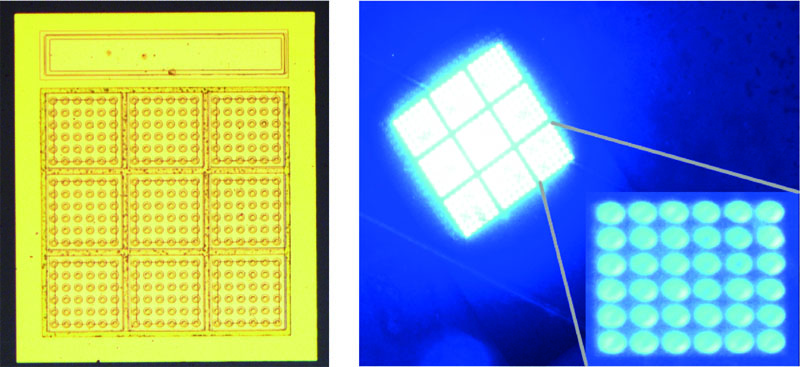NEWS
NEWS
USA researchers have launched the smallest and brightest deep UVC LED in the world
24-04-2021
USA researchers at the University of South Carolina announced that they have successfully developed the worlds smallest and brightest deep-UVC LEDs. Their UVC LEDs, emitting at wavelength of 281 nm, have dimensions down to 5 μm, with arrays producing an output of up to 361 W cm-2.
The technical teams developments will help this class of UVC LED compete against mercury lamps in applications requiring high doses of deep-UV radiation. For some applications, such as face-mask disinfection, the big concerns about toxicity of mercury.
Encapsulation of the UVC LED began by loading AlN-on-sapphire templates into an MOCVD chamber and adopting an epistructure that includes four 2.5 nm-thick Al0.35Ga0.65N quantum wells and a 20 nm-thick p-type Al0.7Ga0.3N electron-blocking layer. Inductively couple plasma reactive-ion etching defined pixel dimensions, before annealing under nitrogen activated the magnesium dopants and ‘narrow picture frame n-contacts were added, around single pixels in standalone devices and around the subarrays of pixels in interconnected devices. According to previous scientific tests, this n-contact geometry will result in current crowding.
On-wafer measurements - using 500 ns pulses and a 0.05 percent duty cycle to minimise device heating - showed that for a single 5 μm-diameter pixel with an aluminium heat spreader, a drive current of 10.2 kA cm-2 led to a peak brightness of 291 W cm-2. This brightness is 30 times higher than that of the other UVC LED.
Tests from the three different arrays show that reducing the pixel size boosts performance, owing to superior heat extraction that quashes thermal droop. Compared with the single-chip reference, the array of 324 pixels with a diameter of 5 μm delivered an increase in the output power of more than five times under CW operation, and more than 15 in pulsed mode.

The above photo shows (left) top-side micrograph of an interconnected array of 5 μm pixels with 5 μm interpixel spacing, and (right) sapphire-side micrograph of the same array under a 60 mA DC current.
The technical teams developments will help this class of UVC LED compete against mercury lamps in applications requiring high doses of deep-UV radiation. For some applications, such as face-mask disinfection, the big concerns about toxicity of mercury.
Encapsulation of the UVC LED began by loading AlN-on-sapphire templates into an MOCVD chamber and adopting an epistructure that includes four 2.5 nm-thick Al0.35Ga0.65N quantum wells and a 20 nm-thick p-type Al0.7Ga0.3N electron-blocking layer. Inductively couple plasma reactive-ion etching defined pixel dimensions, before annealing under nitrogen activated the magnesium dopants and ‘narrow picture frame n-contacts were added, around single pixels in standalone devices and around the subarrays of pixels in interconnected devices. According to previous scientific tests, this n-contact geometry will result in current crowding.
On-wafer measurements - using 500 ns pulses and a 0.05 percent duty cycle to minimise device heating - showed that for a single 5 μm-diameter pixel with an aluminium heat spreader, a drive current of 10.2 kA cm-2 led to a peak brightness of 291 W cm-2. This brightness is 30 times higher than that of the other UVC LED.
Tests from the three different arrays show that reducing the pixel size boosts performance, owing to superior heat extraction that quashes thermal droop. Compared with the single-chip reference, the array of 324 pixels with a diameter of 5 μm delivered an increase in the output power of more than five times under CW operation, and more than 15 in pulsed mode.

The above photo shows (left) top-side micrograph of an interconnected array of 5 μm pixels with 5 μm interpixel spacing, and (right) sapphire-side micrograph of the same array under a 60 mA DC current.


